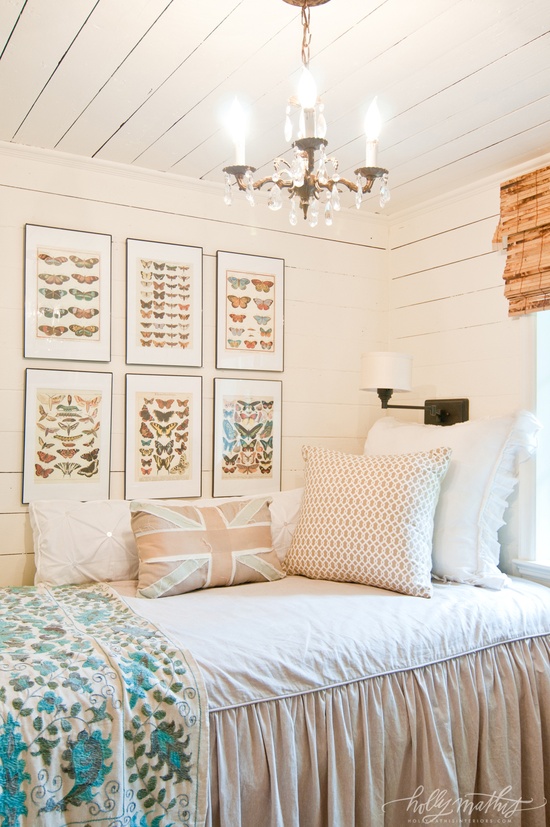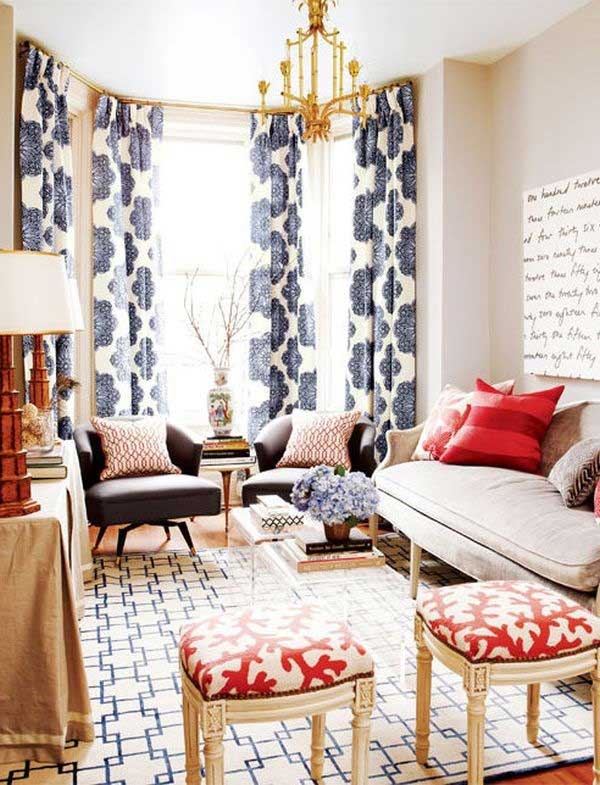When it comes to decorating your living room, one of the best ways to add interest and personality to the space is by mixing patterns. This design approach can add depth and visual appeal to your living room, making it feel cozy, welcoming, and unique. However, mixing patterns can also be intimidating, especially if you are not sure how to do it right. That's why we have put together this guide with tips and tricks to help you master the art of mixing patterns in your living room like a pro. Mixing Patterns in Your Living Room: Tips and Tricks
The key to successfully mixing patterns in your living room is to strike the right balance. You want to create a cohesive look without overwhelming the space with too many different patterns. Here are some tips to help you achieve that balance: 1. Start with a Neutral Base Before you start adding patterns, it's important to have a neutral base to build upon. This means choosing a neutral color scheme for your walls, furniture, and larger decor pieces. This will provide a blank canvas for your patterns to stand out and prevent the room from feeling too busy. 2. Choose a Dominant Pattern When mixing patterns, it's important to have one dominant pattern that will serve as the anchor for the room. This could be a bold floral print, a striped rug, or a geometric wallpaper. Choose something that you love and want to be the focal point of the space. 3. Use Different Scales When choosing patterns, make sure to vary the scale. This means combining large, medium, and small patterns to create a balanced and visually interesting look. For example, pair a large floral print with a small polka dot or a medium plaid pattern. 4. Stick to a Color Scheme Another important factor when mixing patterns is to stick to a cohesive color scheme. This will help tie all the different patterns together and create a harmonious look. You can choose a complementary color scheme, where colors opposite each other on the color wheel are used, or an analogous color scheme, where colors next to each other on the color wheel are used. 5. Mix Textures In addition to patterns, mixing textures can also add depth and interest to your living room. This could include combining a plush velvet couch with a woven jute rug or a smooth leather chair with a fluffy faux fur throw. Mixing textures can also help break up the visual impact of multiple patterns in the room. How to Mix Patterns in Your Living Room Like a Pro
Now that you have some general tips for mixing patterns in your living room, here are some dos and don'ts to keep in mind: Do: • Start small and build up gradually. Don't feel like you need to add every pattern you love in one room. • Use odd numbers when mixing patterns. For example, three different patterns will create a more balanced and visually appealing look than two. • Play with different textures and materials, not just patterns. • Use the 60-30-10 rule. This means using one pattern for 60% of the room, another for 30%, and a final pattern for 10%. Don't: • Be afraid to mix different types of patterns. You can mix florals with stripes, polka dots with plaids, and more. • Use too many bold patterns. It's best to stick with one or two bold patterns and balance them out with more subtle ones. • Forget about negative space. Negative space, or areas with no patterns or designs, are just as important as the patterns themselves. It helps create balance and prevent the room from feeling overwhelming. The Dos and Don'ts of Mixing Patterns in Your Living Room
Now that you have a better understanding of how to mix patterns in your living room, here are 10 ways to put that knowledge into practice: 1. Mix and match different floral patterns in varying scales and colors for a whimsical and romantic look. 2. Pair a bold striped rug with a more subtle striped throw pillow for a classic and timeless look. 3. Combine geometric patterns in different shapes and sizes for a modern and eclectic vibe. 4. Use a large animal print as the dominant pattern and balance it out with smaller, more subtle patterns. 5. Mix different textures, like a chunky knit blanket with a smooth leather couch, for a cozy and inviting space. 6. Play with different shades of the same color for a more subtle and cohesive mix of patterns. 7. Use a bold and colorful patterned wallpaper as an accent wall and balance it out with more neutral patterns in the rest of the room. 8. Combine different patterns in the same color family, like different shades of blue, for a cohesive and calming look. 9. Mix and match different textures and patterns in shades of white for a chic and elegant living room. 10. Have fun with it! Don't be afraid to mix unexpected patterns and experiment until you find a combination that you love. 10 Ways to Mix Patterns in Your Living Room for a Bold and Cozy Space
Mixing patterns in your living room is truly an art form. It takes practice and experimentation to find the perfect balance and create a cohesive and visually appealing space. But with these tips and tricks, you can confidently mix patterns like a pro and create a bold and cozy living room that reflects your unique style and personality. The Art of Mixing Patterns: Living Room Edition
When done correctly, mixing patterns can add an incredible amount of depth and visual interest to your living room. However, it's important to create a cohesive look so that all the different patterns work together harmoniously. Here are some tips to help you achieve a cohesive look when mixing patterns in your living room: • Stick to a color scheme: As mentioned earlier, choosing a cohesive color scheme is key when mixing patterns. This will help tie all the different patterns together and create a harmonious look. • Vary the scale: As a general rule, you want to mix patterns that are different in scale. This means combining a large pattern with a medium or small one to create balance and visual interest. • Choose a common element: To create a cohesive look, it can be helpful to choose one common element among your patterns. This could be a color, a shape, or a texture that is repeated throughout the room. • Use negative space: Don't forget about negative space! Leaving some areas of the room free of patterns helps create balance and prevent the space from feeling overwhelming. Creating a Cohesive Look: Mixing Patterns in Your Living Room
If you're still not sure where to start with mixing patterns in your living room, don't worry. Here are some inspirational ideas to help get your creative juices flowing: • Combine a bold and colorful floral print with a more subtle striped or geometric pattern for a fun and eclectic look. • Mix different shades of the same color, like different shades of blue or green, for a visually interesting and cohesive mix of patterns. • Use a large and bold pattern, like a chevron or animal print, as the dominant pattern and balance it out with smaller and more subtle patterns. • Play with different textures, like a smooth velvet with a nubby knit, for a cozy and inviting space. • Mix and match different patterns in the same color family for a subtle and cohesive look, like different shades of gray or beige. Mixing Patterns in Your Living Room: Inspiration and Ideas
Mastering the mix of patterns in your living room takes some practice and experimentation. Here are some additional tips to help you achieve the perfect mix: • Don't be afraid to mix different types of patterns, like florals with stripes or plaids with polka dots. • Use odd numbers of patterns, like three or five, for a more balanced and visually appealing look. • Experiment with different textures and materials, not just patterns. • Stick to a color scheme to create a cohesive and harmonious look. Mastering the Mix: How to Combine Patterns in Your Living Room
If you're new to mixing patterns, it can seem overwhelming at first. But don't worry, with these tips and tricks, you'll be mixing patterns like a pro in no time. Here are some additional tips to help beginners successfully mix patterns in their living room: • Start small and build up gradually. Don't feel like you need to add every pattern you love in one room. • Stick to a cohesive color scheme to create a harmonious look. • Use different scales, like large, medium, and small patterns, to create balance and visual interest. • Have fun with it! Don't be afraid to mix unexpected patterns and experiment until you find a combination that you love. Mixing Patterns in Your Living Room: A Beginner's Guide
When it comes to mixing patterns in your living room, the possibilities are endless. From stripes to florals, plaids to polka dots, there are so many ways to combine patterns for a bold and cozy space. Here are some final tips to help you mix patterns like a pro: • Use a dominant pattern as the anchor for the room and balance it out with smaller and more subtle patterns. • Mix and match different textures for added depth and interest. • Stick to a cohesive color scheme to tie all the different patterns together. • Experiment and have fun with it! Don't be afraid to mix unexpected patterns and create a unique and personalized space. With these tips and tricks, you can confidently mix patterns in your living room and create a bold and cozy space that reflects your unique style and personality. Have fun and happy decorating! From Stripes to Florals: How to Mix Patterns in Your Living Room
Mixing Patterns in Your Living Room: Creating a Unique and Cohesive Space

Why Mix Patterns?
 When it comes to designing your living room,
mixing patterns
can add a whole new level of dimension and interest to the space. It allows you to create a unique and personalized look that reflects your personal style. Mixing patterns can also help to break up monotony and add a playful touch to an otherwise neutral space. However, it can be intimidating to mix patterns, as it may seem like a daunting task to create a cohesive and visually appealing design. But fear not, with the right approach and a little bit of creativity, you can easily achieve a well-balanced and stylish living room.
When it comes to designing your living room,
mixing patterns
can add a whole new level of dimension and interest to the space. It allows you to create a unique and personalized look that reflects your personal style. Mixing patterns can also help to break up monotony and add a playful touch to an otherwise neutral space. However, it can be intimidating to mix patterns, as it may seem like a daunting task to create a cohesive and visually appealing design. But fear not, with the right approach and a little bit of creativity, you can easily achieve a well-balanced and stylish living room.
How to Mix Patterns
 The key to successfully
mixing patterns
is to find a common thread that ties them all together. This can be a color scheme, a similar design style, or even a shared pattern. For example, if you have a bold geometric rug, you can incorporate smaller geometric patterns in your throw pillows or curtains. This will create a sense of harmony and flow in the room. Another tip is to vary the scale of the patterns. Mixing large-scale patterns with smaller ones can add visual interest and prevent the room from feeling overwhelming.
The key to successfully
mixing patterns
is to find a common thread that ties them all together. This can be a color scheme, a similar design style, or even a shared pattern. For example, if you have a bold geometric rug, you can incorporate smaller geometric patterns in your throw pillows or curtains. This will create a sense of harmony and flow in the room. Another tip is to vary the scale of the patterns. Mixing large-scale patterns with smaller ones can add visual interest and prevent the room from feeling overwhelming.
Choosing the Right Patterns
 When it comes to
mixing patterns
, there are no hard and fast rules. However, there are some guidelines that can help you create a cohesive look. First, choose patterns that complement each other rather than compete. This means selecting patterns that have a similar color palette or style. It's also important to consider the overall aesthetic of your living room. If you have a modern and minimalist space, opt for clean and simple patterns. If your living room has a bohemian or eclectic vibe, you can play with more bold and eclectic patterns.
When it comes to
mixing patterns
, there are no hard and fast rules. However, there are some guidelines that can help you create a cohesive look. First, choose patterns that complement each other rather than compete. This means selecting patterns that have a similar color palette or style. It's also important to consider the overall aesthetic of your living room. If you have a modern and minimalist space, opt for clean and simple patterns. If your living room has a bohemian or eclectic vibe, you can play with more bold and eclectic patterns.
Practical Tips for Mixing Patterns
 To avoid overwhelming your living room with too many patterns, it's important to balance them out. Limit the number of patterns you use and vary the scale and size. This will create a more visually appealing and cohesive look. Additionally, incorporating solid colors and neutral pieces can help to ground the space and provide a break from the patterns. Another practical tip is to use a variety of textures in your patterns. This can add depth and dimension to the room, making it more visually interesting.
In conclusion,
mixing patterns
in your living room is a fun and creative way to add personality and style to your space. By following these tips and guidelines, you can easily create a cohesive and visually appealing design that reflects your personal taste. So don't be afraid to mix and match patterns, and have fun creating a unique and beautiful living room.
To avoid overwhelming your living room with too many patterns, it's important to balance them out. Limit the number of patterns you use and vary the scale and size. This will create a more visually appealing and cohesive look. Additionally, incorporating solid colors and neutral pieces can help to ground the space and provide a break from the patterns. Another practical tip is to use a variety of textures in your patterns. This can add depth and dimension to the room, making it more visually interesting.
In conclusion,
mixing patterns
in your living room is a fun and creative way to add personality and style to your space. By following these tips and guidelines, you can easily create a cohesive and visually appealing design that reflects your personal taste. So don't be afraid to mix and match patterns, and have fun creating a unique and beautiful living room.


















:max_bytes(150000):strip_icc()/Living-Room-with-Pattern-58952acc5f9b5874ee6ba990.png)


































:max_bytes(150000):strip_icc()/Living-Room-with-Pattern-58952acc5f9b5874ee6ba990.png)








































